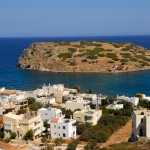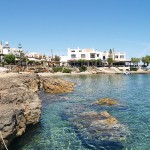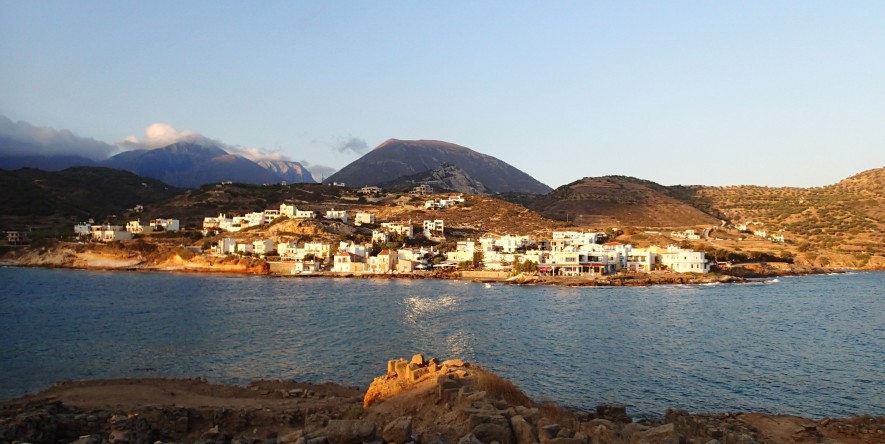 Mochlos (Μόχλος) is an idyllic seaside village in northeast Crete. It’s currently home to just over 200 people year-round, though this number doubles then triples as the summer month’s progress. It’s raison d’être is and has always been the tranquil harbor and bay created naturally by the area’s unique coastal geomorphology. The harbor and bay is the heart of the modern village, a watery town-square (νερό πλατεία). Tavernas, cafés, and bars gird the shore around it and roads and other structures are oriented towards it. Still a peaceful anchorage, today the bay is utilized for more recreational purposes (i.e., swimming, floating, snorkeling, fishing, skipping stones, and a focal point for daydreaming). The village and sea are truly fused. There isn’t a corner of Mochlos where you can’t feel its effect. Salt spray charges the air with subtle tranquility and softness. The rhythmic roll of pebbles being pushed and pulled along the shore is ever-present. The sea even affects the sunlight in Mochlos, distilling it into purity, clarity, and warmth. While traveling the Aegean John Steinbeck said, “here was a penetration of the light into solid substances, so that I seemed to see into things, deep in, and I’ve seen that kind of light only in Greece.”
Mochlos (Μόχλος) is an idyllic seaside village in northeast Crete. It’s currently home to just over 200 people year-round, though this number doubles then triples as the summer month’s progress. It’s raison d’être is and has always been the tranquil harbor and bay created naturally by the area’s unique coastal geomorphology. The harbor and bay is the heart of the modern village, a watery town-square (νερό πλατεία). Tavernas, cafés, and bars gird the shore around it and roads and other structures are oriented towards it. Still a peaceful anchorage, today the bay is utilized for more recreational purposes (i.e., swimming, floating, snorkeling, fishing, skipping stones, and a focal point for daydreaming). The village and sea are truly fused. There isn’t a corner of Mochlos where you can’t feel its effect. Salt spray charges the air with subtle tranquility and softness. The rhythmic roll of pebbles being pushed and pulled along the shore is ever-present. The sea even affects the sunlight in Mochlos, distilling it into purity, clarity, and warmth. While traveling the Aegean John Steinbeck said, “here was a penetration of the light into solid substances, so that I seemed to see into things, deep in, and I’ve seen that kind of light only in Greece.”
In the landscape, the village rides the borderline between mountains and sea. The jagged ridges and peaks of the Orno Mountains encircling the Mochlos Plain fall and ruck and stutter their way down into the Mediterranean. From the shore the terrain looks like a series of giant steps, and also a lot like a dream. Geologically, the Mochlos Plain is a large tectonic valley known as a graben (a large block of stone broken from its surroundings slowly moving towards the center of the Earth while the land around it shifts skyward). East of the village where the sun rises stands an enormous shear cliff-face, the scar where the fallen plain once connected. The slow sinking of the tectonic valley has submerged the landbridge (isthmus) that connected the area of the modern village to the tiny island where our marriage will take place. The tiny island is one large archaeological site that you can read about in a few paragraphs. The submerged isthmus is easily recognized when observed from the hills above the village (you’ll probably see it on your drive in), but you can take a closer look by swimming alongside it with a mask (our favorite). The inundation of the landbridge sometime after the first century led to the eventual abandonment of the site, and has much to do with the sites remarkable preservation.
The massive fallen block (the Mochlos Plain) has been further altered by a series of eight parallel streams roughly equidistant apart. Each stream has cut deep incisions into the landscape leaving ridges and knobs in between steep-sided valleys. These watersheds are an excellent place to go hiking, especially the ones in the east. You’ll likely encounter hawks and kites and you might even spot the endangered griffin vulture or even a lammergeyer (aka bone crushing condor). The ridges, knobs, and hillsides are covered in thousands of olive trees. The valleys are full of brambles, vines, garden plots and orchards. Accompanying you on your hike will likely be the slightly annoying trill of cicadas and the pleasant aroma of oregano and thyme growing wild under the olives and by the roadside. Several shepherds still graze the wild and feral areas of the hills and plain. You might encounter one of these gentlemen on your weekend with us and think you’ve transcended time. You may have.
On the whole, the people of Crete are incredibly nice and hospitable, but the people of Mochlos and the surrounding villages are possibly the sweetest people in the world. Greece is home (really the birthplace) to a special type of hospitality, Xenia (ξενία); first mentioned in Homer’s Iliad. It took us some time to get used to it. We understood the concept of hospitality to represent someone (usually an aunty or grandparent) who was a good host at their house, you know, good food, forcing seconds, filling your glass, but of course you had to be invited. In Greece—especially in the islands—xenia means so much more. First of all, you don’t have to be invited to the island, town, or village but the local people bend over backwards to help you find your way to comfort and ease. For example, we’ve asked for directions from a perfect stranger, they delivered them, then offered to put us in contact with their friends at the destination if we needed a place to stay for free or a meal to eat. From an American standpoint this sounds a bit fishy, but there it’s not. We’ve had meals paid for by elderly strangers whom we never even spoke to, or had a chance to speak to; they just treated us and walked away. One of our favorite Greek proverbs is: ‘do a good deed, then throw it in the sea!’.
Our other favorite proverb is ‘slowly slowy, one goes far’,‘Siga siga, pie kanies makria.’ Pay close attention to this part, because understanding this will either be the key unlocking a beautiful experience on Crete or a source of frustration. Things move slowly on the Greek Islands, and slowly slowly on Crete. The tempo of Cretan life is a steady calm heartbeat. Remember that this is a land that has seen so much uniterrupted history, so many tomorrows. In the States it’s common to feel like there isn’t enough time to get everything done in a day or week, but the sentiment on Crete is that there is just enough time for everything… so don’t worry! It takes some getting used to. There is nothing quick about conversations. There is nothing quick about going for a cup of coffee. There is nothing quick about going out for a meal. The service is slow and steady: menus, drinks, mezes, meal, drinks, fruit, and raki (Cretan moonshine, like grappa but better). It’s not uncommon to spend most of your day just having two meals. Crete forces you to slow down. ‘Siga siga’ is the mantra you’ll all have to adopt for our wedding weekend, and perhaps beyond.
The little island sitting just offshore from the modern village is where our ceremony will take place. We’ll all take boats across late afternoon on June 27th. Seen from above the island loosely takes the shape of a heart. At its point is a tiny whitewashed church built from spolia and dedicated to Agios Nikolaos, the patron saint of seafarers. This is far and away the most recent construction you’ll see on the island. Surrounding it are the architectural remains of several iterations of a harbor town. The earliest walls date to 2200 BCE. This was essentially the first Mochlos village. The inhabitants during this time utilized the naturally tranquil bay to harbor their fishing vessels and as a port for trade. The earliest ‘Mochlosians’ specialized in peddling obsidian collected from the volcanic island of Milos. There is no source of obsidian on Crete. Obsidian glass held the sharpest edge of any cutting tool in antiquity, so you can imagine its utility and demand in the region. The prosperity of these founders is easily understood by visiting their elaborate house tombs located on the west-side of the island; their golden objects can be seen in several museums across Crete. It was probably during this time, the so-called Early Minoan II period, that Mochlos held its first wedding celebrations. The early village developed in fits and starts and by 1700 BCE it took the shape of a true town. Avenues and streets were laid out in the cardinal directions creating a series of blocks, just like we see in Philly, Southern Pines, and basically everywhere else. A strong middle class of merchants and craftspeople constructed large multistory houses. A beautiful ceremonial building was erected in the heart of town. This was perhaps the wedding venue of yesteryear. Craft production was located in the artisans quarter just behind the modern village (your cars will likely be parked right next to it), and these goods along with olive oil, wine, and grains were exported all over the Aegean, the mainland, Anatolia, the Levant, and Egypt. We have even found material from as far away as modern Afghanistan. This period between 1700 and 1450 BCE was the cultural apex of ancient Mochlos and the architecture from this time constitutes most of what you’ll see on your visit. This was the period of the great Minoan Palaces, like Knossos and Phaistos, which you should try and see before or after we tie the knot. There is much much more to be said about the archaeological site, so Jonathan will lead several tours before and after the wedding for those interested.
 Back to the modern village. We doubt anyone will have the chance to find boredom during our eventful wedding weekend, but if you decide to come early or stay longer here are some things you might consider doing. Swim everyday. Bring or buy a dive mask. The seafloor is folded and faulted into miniature underwater mountains and valleys, another world filled with brilliantly colored fish, crabs, and octopi. Hike or promenade every evening. Our favorite walk is to the Venetian tower located about 45 minutes on foot east of the village; it’s home to several stately owls. Eat out everyday. You’re on vacation. There isn’t a large grocery store in the village anyway. The food is totally affordable and completely delicious and the experience is a lot like going to a spa, an eating spa. You’ll see several traditional fishing vessels bobbing out in the evening and returning home in the early morning light. These men are supplying the fish that you’ll see on ice at the tavernas in the village. It doesn’t get much more fresh than this. If you’re not big on seafood (if this is the case, we’re sorry from the bottom of our wanna-be-greek-hearts), you should try the local Cretan cuisine (mousaka, lamb stew, vleeta, roasted eggplant, gemista, dolmades). Make an effort to talk to the locals. Most everyone speaks some English and they’re really delightful people. Sun bathe. Taste the wines of the region. There is a small open-deck tour boat that will take you on a sunset cruise or over to the archaeological site. Mochlos Tours is written on the side of the vessel (just ask anyone in the village for Giannetto and your set). And relax, besides you won’t have much of a choice.
Back to the modern village. We doubt anyone will have the chance to find boredom during our eventful wedding weekend, but if you decide to come early or stay longer here are some things you might consider doing. Swim everyday. Bring or buy a dive mask. The seafloor is folded and faulted into miniature underwater mountains and valleys, another world filled with brilliantly colored fish, crabs, and octopi. Hike or promenade every evening. Our favorite walk is to the Venetian tower located about 45 minutes on foot east of the village; it’s home to several stately owls. Eat out everyday. You’re on vacation. There isn’t a large grocery store in the village anyway. The food is totally affordable and completely delicious and the experience is a lot like going to a spa, an eating spa. You’ll see several traditional fishing vessels bobbing out in the evening and returning home in the early morning light. These men are supplying the fish that you’ll see on ice at the tavernas in the village. It doesn’t get much more fresh than this. If you’re not big on seafood (if this is the case, we’re sorry from the bottom of our wanna-be-greek-hearts), you should try the local Cretan cuisine (mousaka, lamb stew, vleeta, roasted eggplant, gemista, dolmades). Make an effort to talk to the locals. Most everyone speaks some English and they’re really delightful people. Sun bathe. Taste the wines of the region. There is a small open-deck tour boat that will take you on a sunset cruise or over to the archaeological site. Mochlos Tours is written on the side of the vessel (just ask anyone in the village for Giannetto and your set). And relax, besides you won’t have much of a choice.
We selected Mochlos for several reasons. First of all it’s crazy beautiful: the village, the sea, the mountains, the archaeology, the landscape. Secondly, it’s full of great people with great energy. It’s also a very important place for Jonathan; he’s been working on that little island for the last 10 summers. We also felt something akin to magic being on the island. Our union and our love solidified there in a way that… well… it just felt magic! It’s awfully hard to describe, but it probably has something to do with the fact that just underfoot in this timeless landscape are the stories of so many couples that came together to build their dreams and make a family and pass the torch of love. It’s our turn to carry it. We really look forward to passing time with you in this beautiful place and celebrating the power of love and our incredible union.
For more info on the modern village follow this link (http://www.mochlos.eu/) and for the ancient village and excavations (http://www.uncg.edu/arc/Mochlos/first.html). Yammas!
